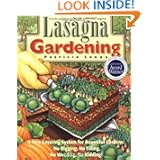Bermuda grass makes a nice lawn because it can take a Texas drought. It will turn to brown and go dormant with no water and return to green lush lawn when the rains come. It also spreads easily by runners and stolons (those little roots formed from runners).
 |
| Starting point picture. Grass. All grass. |
Last year, I started with just cardboard beneath the raised beds. Bad idea. The grass just joined the plants in one happy grow-fest!
This summer, I tested several different methods of killing the grass. I tried solarizing with clear plastic, solarizing with a tarp, and sheet mulching. What I refuse to do is till.
Results have definitely taught me how to move forward. See the results below.
Tilling: A neighbor tilled her bermuda grass lawn in spring before putting in her garden. BAD IDEA! Yes, I'm shouting. lol! What tilling does for bermuda grass is chop it into tiny bits that each then sprout into a new plug of grass. She actually created more grass in her garden not less. Her garden was so covered in grass that she gave up on her garden.
Solarizing with clear plastic: Clear plastic seemed to work at first. It definitely dried the grass to a crunchy brown. I thought I had success. However, once that plastic was removed, the exposure to air and water revived the grass. This is why so many lawns in Texas are bermuda grass. It can look dead, then a little, very little, sustenance from air and water will revive it. Perfect for drought-stricken lawns, not what you want in your garden.
Solarizing with a tarp: I used a green tarp I found in the camping section of Target. First I laid it out as one big sheet. That just acted like shade for the grass, and it kept growing. However, I noticed that in spots where I had put bricks or cinder block down to keep the tarp in place, the grass disappeared. That discovery led to my total commitment to the last test option.
 Sheet mulching: Plain sheet mulching is working best for us. The concept is very simple: layer a thick layer of cardboard over the grass then add mulch, compost, grass clippings, leaves, manure, etc.
Sheet mulching: Plain sheet mulching is working best for us. The concept is very simple: layer a thick layer of cardboard over the grass then add mulch, compost, grass clippings, leaves, manure, etc.Oregon State Paper on Sheet Mulching
It is also trademarked as Lasagna Gardening as explained in the book by the same name: by Patricia Lanza.
My favorite resource on sheet mulching is a movie called "Back to Eden."
Back to Eden Film
A farmer in Washington state teaches about how he learned from looking at what God does to manage creation. He discovered that God loves to cover the land, so that's what he did with wood chips. He has an incredible garden. Scientists have conducted testing on his soil quality, which has tremendous results. And, he never waters. I don't think I can get away with that here in Texas. But, if I can reduce water usage significantly, then that will be a great help.
Sheet mulching takes a LOT of input in the beginning. Because this only works during the grass growing season, I had to abandon my garden this year just like my neighbor. However, I will come out ahead I think. Instead of grass, I have acquired really nice dirt.
I have obsessively scoured Facebook trade groups, Craigslist, and even neighborhoods on recycle days seeking cardboard. In this one summer, I have used the equivalent of about six full household moves worth of boxes. That's a lot of boxes!
What I did was to layer a broken-down cardboard box on top of the grass. Do not cut it open to make it bigger. Leave it doubled up. You want that thickness. I covered this with the tarps and plastic to keep the wind from blowing the cardboard away. I left this in place all summer. What it did was smother the grass, and the contact with the cardboard caused the grass to decompose underneath.
Do not mulch before you have decomposed grass, otherwise you end up with cardboard that decomposes before the grass is dead. The grass will grow up through your mulch. I tested this unintentionally. I had put out cardboard everywhere, but I ran out of mulch after covering just a 15x15 area. That area ended up with grass growing in it, whereas the other areas with just cardboard did not. It was learning by mistakes. lol!
After the grass looks somewhat decomposed, which for me took from May until July, layer a fresh layer of cardboard on top of the rotting cardboard. Now you layer all the other stuff on top of that. Layer it very, very thick, like two to three feet thick.
 |
| Close-up of a section after killing the grass. Beautiful! |
 | |
| Winterized |
Bermuda grass can grow from buried roots, so this process must be repeated for a couple of years before it is truly eradicated.
To direct sow seeds, layer the cardboard very thickly, then build a raised bed on top. Once seedlings have appeared, you can mulch around them.



0 comments:
Post a Comment